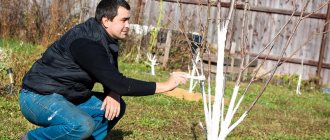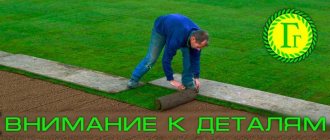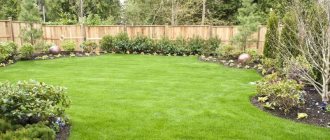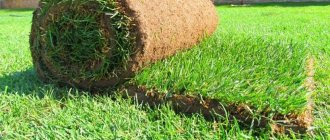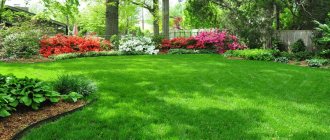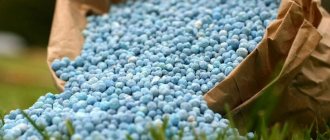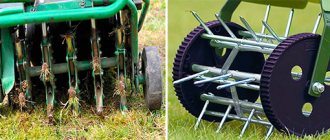Before starting to prepare the land for a lawn near the house and sowing grass, the owner must draw up a plan, clean the area, lay communications, and cultivate the top layer of soil. It is necessary to draw a drawing of the territory to scale, in which small flower beds, decorative ponds, and shrubs should be provided as desired. It is better to immediately plan the placement of lamps, the laying of a water supply system to a reservoir, and a sewer system for draining water.
The first thing to do is decide on the slope of the site so that rainwater can drain freely, and check the foundation under the fences. If it is ribbon and laid to a great depth, then in the event of heavy rains a small pond may appear in the courtyard of the house. During prolonged downpours, the lawn will not withstand such waterlogging and will be hopelessly damaged. Therefore, in strip foundations at the lowest point of the plot, it will be necessary to punch several holes for draining water with a diameter of about 100 mm every 3-4 m at a depth of 30-40 cm.
Important! Pay attention to the tall trees growing in the neighborhood. They should not completely shade the entire area.
Lawn
What types of lawns are there?
Gardeners count 4 types of lawns:
- English, or parterre;
- gardening;
- meadow;
- Mauritanian;
- sports.
Of these, only English is intended for decorative purposes. You cannot lie on it, play, or have picnics. Needs regular care: cutting, watering, feeding with fertilizers. The herbal mixture is expensive compared to others. Only ideal soil preparation for the lawn can ensure even cutting of the grass carpet. Even a small bump or hole will be clearly visible from afar.
Landscape gardening is more resistant to stress, has a certain composition of grasses, and is not afraid of shading from trees, cold, or prolonged rains. It is cheaper to set up and maintain compared to English. Most often used in dachas.
For your information! Meadow is more resistant to stress, easy to care for, and also has a specific composition of herbs. Suitable for home lawns and large areas, does not require frequent mowing of the grass. It contains herbs that bloom all summer long.
Mauritanian differs from the others in the abundance of flowering herbs. They are pleasing to the eye all summer long. They are mowed only after all the flowers have withered: in late summer and autumn. Does not require any care other than watering in dry summers and mineral fertilizing.
The sports one differs from the others in the composition of the herbs. They are selected in such a way that it is not afraid of heavy loads. The lawn is not afraid of trampling and is specially designed for sports fields. You can play football on it, have picnics, or just relax, but it is very demanding to care for. It needs to be watered regularly and mowed weekly.
Soil acidity (pH)
The soil can be alkaline or acidic. The intensity of these indicators is measured on the so-called pH scale with values from 1 to 14. Indicator 1 means highly acidic soil, and 14 means highly alkaline. Some plants, such as camellias or rhododendrons, like acidic soil, while others prefer alkaline soil. Different types of grass are well adapted to both, but most of them still prefer neutral or slightly acidic soil (pH 6.0-6.5).
Preparing the area for a lawn and sowing grass
Sports turf: description, mixture composition and characteristics
Preparing the area for sowing grass can be ordered from specialized companies, but the prices for such work are not low, and everything can be done with your own hands. However, nothing can be aligned by eye. You will have to pull colored threads at an equal distance from the ground along the perimeter, diagonals and in the locations of small architectural forms. They will immediately give a general idea of the scope of work.
Note! If the volume of work is large, it is better to order an excavator or a truck than to carry soil with a wheelbarrow from one end of the site to the other for weeks.
Next, you will need to remove construction debris and large stones. If it is not possible to remove the cobblestones, they can be buried to such a depth that there is a fertile layer of soil above the stones with drainage of at least 20 cm. It is not allowed to leave tree branches, boards, sawdust and similar waste in the ground, expecting that they will be used in the future will rot.
Before final planning, you need to remove the fertile layer of soil with an excavator and dump it into one pile. To prevent weed seeds from being sown again, you will have to cover it with black film. While the planning work is going on, the weeds will die without access to light.
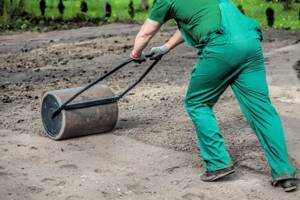
Preparing the area for a lawn and sowing grass
In addition, you will need to do a soil analysis. If the soil is poor, clayey and heavy, you will need to bring in several truckloads of fertile soil. You will definitely have to buy peat if possible, but don’t get carried away. Peat should be no more than 20% of the volume of the top layer of fertile soil. A few cars of fine sand won't hurt either.
[a
Important! The lawn must be perfectly leveled, otherwise the lawnmower will not cut the grass evenly.
What should be the size and weight
On sale today you can find a huge selection of lawn rollers, differing in size, weight, functionality and, accordingly, price. The cost of the product starts from 3,500 rubles, but premium options can cost 16,500 rubles. and higher.
A factory-made manual roller is a large, heavy cylinder mounted on an axle that allows it to rotate freely. The structure is connected to a handle, holding which the “lawn spreader” pushes the roller in front of itself.
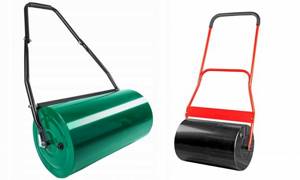
The width of the roller is calculated in such a way that, on the one hand, the work proceeds as quickly as possible, and on the other hand, it is comfortable for a person with average physical fitness to handle the device. On average, these indicators correspond to sizes from 50 to 100 cm.
Approximately the same requirements apply to weight. Ideally, to effectively level a site, the roller should be as heavy as possible, but since the device is used in manual mode, this parameter has to be greatly limited.
Important! Professional lawn rollers weigh from 50 to 120 kg; for this purpose, the roller is made heavier using special fillers. Such devices are attached to self-propelled machines and are used to treat large areas, such as golf courses or football fields.
Manual weight rollers can also be filled with water, sand or cement. Without such manipulations, the average weight of a factory-assembled product is 7–13 kg; further modification depends on the desire and physical capabilities of the individual consumer.
For example, the technical characteristics of the Al-KO GW 50 (Austria) model indicate that with an initial weight of 13 kg, the device can be weighed up to 75 kg when water is poured into it. Knowing that sand on average weighs 1.8 times heavier than water, it is easy to calculate that this parameter increases to 135 kg through simple manipulations.
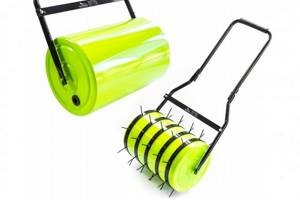
In addition to the usual rolling roller, some products are equipped with an additional attachment - an aerator. It looks like a barbed net that is put on a roller. This function is used to loosen the soil before sowing grass.
How to prepare the land for sowing lawn grass
If the owners do not plan to remove the fertile layer and lay various communications (electrical cables, pipes), then first you need to get rid of grass and weeds. There are two options for dealing with unwanted herbs.
How to make a lawn at your dacha with your own hands: step-by-step instructions
In the first case, you need to dig up the soil, carefully turning it over with the grass cover facing down. This is a difficult task and not always effective.
On a note! The second option recommends using weed control chemicals such as Roundup and the like. However, it is worth considering that the “chemistry” acts on plants through leaves and stems and has absolutely no effect on the seeds. Therefore, between the first and subsequent treatments you need to wait about 2-3 weeks. During this time, young shoots will emerge from the sown seeds and then the grass should be treated a second time. After this, you can begin digging and leveling.
The influence of seasons on work
A lawn can be laid out in two different ways: quickly for a lot of money and cheaply with your own hands. In the first case, the seasons and weather do not affect anything. And if you do everything yourself, the preparation for the lawn will take six months. The area for the lawn should be prepared in the fall and completed in early spring. Reasons why you should do this:
- In autumn, all the weeds with long roots are visible. They are not that difficult to fight. You need to treat the grass with Roundup and boldly begin leveling. In a couple of weeks the earth will settle and it will be clear where to add and where to remove the excess.
- As soon as the snow melts, you should wait until the first shoots appear, and then process the crops again. Having completely destroyed the extraneous grass, you should start sowing the lawn. At this time, the plants have not yet begun to bloom, they do not throw out seeds, so there is a reserve of time for spring work.
Note! When purchasing seeds, it is recommended to increase the rate by 10%. This means sowing the grass according to the instructions, and leaving 10% in reserve. After the first shoots, it will be clear where the grass needs to be replanted.
How to level an area and speed up work
To prevent leveling from turning into exhausting work, you need to chop the top layer of soil with shovels, hoes, and rakes to a depth of 0.5-1 cm. In large areas, you can use hand cultivators or walk-behind tractors for this. After grinding the top layer of soil, a long (6 m) lath with a cross section of 70*100 mm is needed for leveling. The procedure consists of two people pulling it across the entire area in all directions. This operation will significantly speed up the work. The sharp edges of the slats cut off excess soil and pour it into the recesses.
How to test soil acidity
Before you start preparing leveled soil for the lawn before planting bushes and sowing grass, you need to determine its acidity. For lawn grasses, the best pH is no higher than 7. This indicator corresponds to neutral soils. There are several ways to determine the pH level:
- laboratory;
- independently with litmus paper;
- a portable device that tests soil acidity;
- on growing plants.
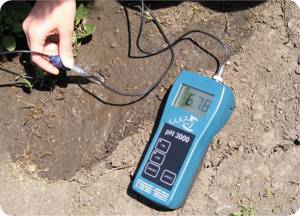
How to test soil acidity
Important! If possible, you can use a portable device to measure soil acidity. It will show the acidity level at any point with high accuracy.
In the first case, you need to take samples from several points in the garden at a depth of about 10 cm and take them to the laboratory. In a few minutes the results will be ready.
In the second, you will need to buy litmus papers and distilled water. It is necessary to stir soil samples in distilled water and check the acidity with a litmus indicator.
You can also simply pay attention to the plants growing in your dacha area. Based on their number and types, the acidity of soils can be approximately determined. On acidic soils grow:
- chamomile;
- horse sorrel;
- most types of mosses;
- mint;
- wild rosemary;
- creeping wheatgrass;
- field bindweed.
Important! If at least one of these types of plants grows near the house, it means the soil is acidic and requires deacidification. For this, dolomite flour, chalk, and fluff lime are used.
How to choose seeds for different types of lawn
The modern industry of lawn mixtures has provided an assortment for all types of lawns, for different climatic conditions. To choose the right seeds, you need to carefully analyze the situation in your area. First of all, decide what you need a lawn for - for beauty, recreation, sports or parking. The resistance of the grass to trampling depends on this.
The cereals included in the mixture are mostly light-loving plants, but there are some that can withstand partial shade. Lighting features are an important factor for the lawn. The relationship of herbs to moisture cannot be overlooked. If it is not possible to water daily, it is better to choose drought-resistant mixtures. In areas with cold winters, you will need a lawn with increased frost resistance. In a word, the mixture of lawn grasses must fully comply with the environmental conditions of your site.
The following brands are popular:
| № | Blend name | Features of use |
| 1. | Grass Fix | It is characterized by fast and uniform growth, is resistant to trampling, tolerates low temperatures well, and is used for constructing playgrounds. Recommended for restoring missing areas of the lawn. |
| 2. | Robustic | One of the most winter-hardy mixtures. Suitable for decorative landscaping. Not intended for walking. Requires good lighting and watering and is rarely susceptible to disease. |
| 3. | A park | Made from slow-growing, shade-tolerant grasses with increased wear resistance. You need to mow once every 2-3 weeks. |
| 4. | Sport | For sports fields, football and golf fields, parking lots. It is highly resistant to trampling. The mixture is drought-resistant and durable. |
| 5. | Shady alley | Used under openwork tree crowns through which sunlight penetrates. |
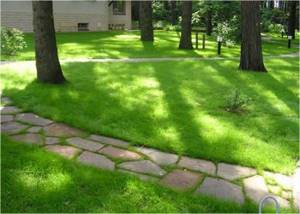
The Shady Alley lawn grass mixture tolerates partial shade. Where there is no sun at all, lawns do not grow.
Drainage device
How to prepare the ground for a lawn with a high groundwater level or in a wetland? To do this, you will need to ensure high-quality drainage of excess water. The type of drainage system is selected depending on the soil and the level of groundwater rise during peak periods. For sandy loam soils, as well as when the site is located on a hill, with natural removal of excess moisture (the presence of deep ravines, ditches, etc. nearby), drainage is not necessary.
There are two options for drainage systems:
- solid;
- channel
Note! Continuous drainage is arranged only for heavy clay soils. To do this, the fertile layer is completely removed and gravel, sand, broken brick, and small stone about 150 mm thick are laid on the clay. Preparing an area for a lawn involves draining excess water in its lower part.
Channel drainage systems are used on waterlogged soils with a high groundwater level and the risk of flooding the area as a result of melting snow. The simplest method is to dig ditches and fill them with small stones, crushed stone and sand. For swampy areas, drainage is made from asbestos or plastic pipes. They are placed in cushions of sand or fine gravel. For proper installation, you need to make a geodetic survey of the plot to determine the direction of drainage of groundwater and melt water. Duct systems are expensive and labor-intensive to implement.
Determine what kind of soil you have
If you don't know what type of soil you have on your property, go out into the garden on a dry day, take a handful of soil in your palm, squeeze it, then open your palm. Take a close look at the color and structure of the earth.

- The sandy soil flows easily between your fingers. Feels rough and grainy to the touch.
- Clay soil is greyish rather than brown. It is sticky to the touch and forms a lump when squeezed.
- Peat soil is dark, soft and loose. If it is wet, then by squeezing your palm you will get a few drops of water out of it.
- Limestone soil has a light, grayish-brown color that you'll recognize before you squeeze it. It is grainy to the touch, has white inclusions and is quite crumbly, so it does not form a lump.
- The color of loam varies from medium to dark brown. It is soft and crumbly to the touch; if wet, it forms a soft lump.
Creation of rolled lawns
Interesting! This is the fastest way to install lawn coverings. Rolls of earth with a synthetic mesh base and sown perennial grasses are laid on a prepared base with drainage and laid communications.
How to prepare the soil for a rolled lawn? The work is no different from installing an ordinary lawn. For quick and easy installation, you need to compact the top layer with heavy rollers to compact and better contact the laid turf mats with the ground. With regular watering, the result will be visible in 2-3 weeks.
Tips for preparing the soil for rolled lawn:
- When laying a fertile layer of soil, it is worth remembering that over time it compacts and sags. To install a simple parterre lawn, the thickness of the fertile layer should be at least 20 cm after shrinkage. That is, you will have to pour fertile soil 25-27 cm thick, taking into account future shrinkage.
- If the soil is sandy or sandy-gravel, then more clay needs to be added to the fertile layer to retain moisture.
- To perfectly level the ground for laying rolled lawn, you need to use a thin layer of sand. The root system of plants can easily overcome the sand and penetrate into the nutrient layer of the prepared soil.
- Before laying the lawn, it is recommended to apply nitrogen mineral fertilizers to the top layer of soil.
- It should be taken into account that in the spring it is better to apply nitrogen mineral fertilizers to form the bright green color of the grass. In autumn, on the contrary, you need to add fertilizers with a predominance of potassium and phosphorus for better formation of the root system.
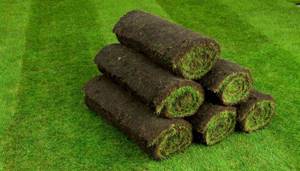
Creation of rolled lawns
Determination of soil composition
What kind of soil should it be? Before planting, it is necessary to analyze the quality of the soil. To do this, the sample is sent to the laboratory, where the pH level and composition of the soil are determined. The optimal pH level is considered to be between 6.5 and 7. However, this indicator is very rare. Therefore, if the soil is acidic, you need to add limestone to it. If, on the contrary, the soil is alkaline, then sulfur can be added.
The composition of the soil also plays an important role in the growth of a thick and high-quality lawn. If the soil is too sandy, it will not retain water. On the other hand, although clay soil retains moisture, insufficient aeration will require more time for the liquid to reach the roots of the grass. The best option for a lawn is loamy soil. It has fairly good aeration and retains water for a considerable time. You can artificially achieve the required composition: add clay to sandy soil, and sand to clay soil. In this way some balance will be achieved.
To improve the soil structure, you can add organic matter, such as compost. Organic matter improves the properties of the soil: the soil is loosened and water is better retained.
It is also necessary to add initial fertilizer, that is, useful substances that are added to the soil before. Such fertilizers contain a large amount of phosphorus, due to which the lawn roots are better anchored in the soil. However, if the results of the soil test revealed that phosphorus is contained in sufficient quantities, then there is no need to add the initial fertilizer.
Fertilizers must be applied to the soil 7-10 days before sowing. The substances are dug evenly into the soil and then leveled with a rake. When digging, it is necessary to remove large roots of weeds: dandelions, woodlice, clover, etc.
Serious mistakes gardeners make when preparing soil for the lawn
- Uneven soil layer. Over the entire area of the lawn, the soil depth should be the same, otherwise, where there is more soil, the grass will be thicker and juicier, and the lawn will turn out “spotty”.
- No slope. On a flat surface, excess water does not have time to be absorbed and washes out the lawn after the first heavy rain.
- Sowing seeds in heavy clay soil. Modern lawn mixtures require light soil. In clayey conditions, cereals die.
Rate the quality of the article. We want to be better for you:
Cost of finished coating
When choosing a rolled lawn, the price of which will not blow your budget, it is important to know that the cost of coverage consists of many components:
- The mixture that is used for planting. The price of rolls directly depends on the grass from which the lawn is grown. They determine the external attractiveness of the coating and its performance characteristics.
- Order volume - the larger the delivery batch, the cheaper each square meter of the equipped site will cost.
- Remoteness of the site - the further away the installation site is, the more expensive the delivery of finished rolls will be, and, accordingly, the total cost of the project will increase.
You can study more detailed information about how the soil is prepared and the correct planting of the lawn is carried out on the website.
Caring for the soil of a growing lawn
To make the lawn look like an emerald carpet, it is important not only to properly prepare the soil when installing it, but also to provide it with everything necessary in the future. The most important thing is watering:
- The optimal water temperature is +180 – +250. (You cannot water cold water from a well or deep well.)
- The amount of water per 1 m2 is 15 – 20 liters.
- It is better to water in the morning or evening, but not during the sun. In hot weather, drops of water burn the grass, creating a greenhouse effect.
In addition to watering, the lawn needs fertilizing. Global nutrition is carried out using mulching.
Features of soil mulching
In the spring, after the soil has dried enough to begin gardening, the lawn is cleared of dry plant debris. It is better to do this with a rake with sharp teeth, which not only collects grass and felt, but also destroys the film on the ground that has formed over the winter. After this, the lawn is mulched with sifted peat or light soil mixed with complex lawn fertilizer. This feeding is carried out annually.
Prevention and treatment of diseases and pests
Lawn grasses, just like other plants, are susceptible to diseases. Danger may lurk in the soil. To prevent your lawn from becoming infected, it is better to take preventive measures in advance without waiting for the pathogens to spread.
- Do not allow the lawn to become waterlogged; fungus thrives in a wet environment. To prevent water from stagnating, the lawn is pierced after watering. Old lawns are scarified and the top, overly compacted layer is removed (torn off).
- Regularly clear the lawn of grass clippings. When dry, small leaves become compacted on the soil surface, blocking air access. Even if the lawn mower has a grass collector, you still need to repeat this procedure from time to time, because all the grass does not fall into the collector; some remains on the lawn.
- Fertilizing plays an important role in the decorative appearance and “health” of the lawn. Mineral fertilizers are preferable for the lawn.
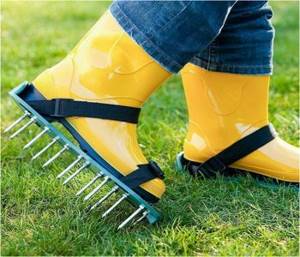
The lawn is pierced to better allow water and air to flow into the soil.

